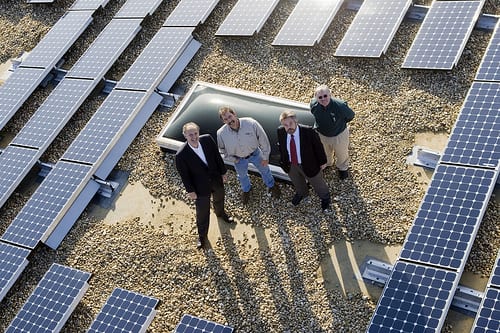The eastern US state of Maryland has completed construction of its first commercial solar microgrid – one of the first for the nation: a 402kW system combining grid-interactive energy storage and a 1,368 panel solar PV canopy array.
The milestone microgrid project was developed by Standard Solar and Solar Grid Storage for Konterra Realty corporate headquarters in Laurel, Maryland.
Konterra is the real estate group behind the eponymous 9 square kilometer mixed-use development, located between Washington DC and Baltimore, which when completed will include a town center, retail and hospitality venues, technology campuses, educational facilities, and residential and business communities.
The solar microgrid system is expected to generate of 20 per cent of the annual building power for the Konterra headquarters, as well as power for two electric vehicle charging stations and LED parking lot lighting. The energy it will generate is equivalent to the electrical usage of about 57 American homes for one year or removing 90 passenger vehicles from the roads per year.
The PV array would also stay online in the event of a conventional power grid outage, with the batteries of the advanced energy storage system able to maintain a critical load of 50kW for just over four hours overnight and recharge the next day.
Joining Maryland’s Governor Martin O’Malley to celebrate the completion of the solar microgrid was Jon Wellinghoff, chairman of the Federal Energy Regulatory Commission (FERC), which regulates utilities in the US.
Wellinghoff has long been a fan of distributed solar energy, predicting in an interview in August that solar would “overtake everything”, and that once storage was brought in to the equation it would be pretty much “game over” for traditional forms of generation.
“Solar is growing so fast it is going to overtake everything,” he told Greentech Media on the sidelines of the National Clean Energy Summit in Las Vegas. “At its present growth rate, solar will overtake wind in about ten years. It is going to be the dominant player. Everybody’s roof is out there,” he said. “Once it is more cost-effective to build solar with storage than to build a combustion turbine or wind for power at night, that is ‘game over.’ At that point, it will be all about consumer-driven markets.”
He noted that in the next 2.5 years, the US would double its entire cumulative capacity of distributed solar built up over the previous four decades, and the installation cost of solar would continue to plunge from its current level of $4-$5 a watt, to $2 a watt and $1 a watt.
Speaking at the Konterra event on Tuesday, Wellinghoff was singing the praises distributed energy storage: “Energy storage not only provides substantial value to the electric grid, it makes the integration of solar PV and other distributed generation systems reliable, efficient and cost-effective as well,” he said. “Distributed storage is an important piece of the puzzle as we deploy new resources to generate energy.”
Interestintly, Wellinghoff’s proposed successor as FERC chief – unanimously endorsed by federal commissioners – has been vetoed by Republicans in Congress because he was seen as “too favourable” to renewables.
Funding for the project came from the MEA Game Changer Competitive Grant Program, part of the Strategic Energy Investment Fund, created to provide cost-sharing grants for innovative clean energy generation technologies and market strategies in Maryland. The projects are funded according to their ability to help the state meet its renewable energy target of 20 percent by 2022.
Additional project funding was provided by Konterra, PNC Bank and Solar Grid Storage.










